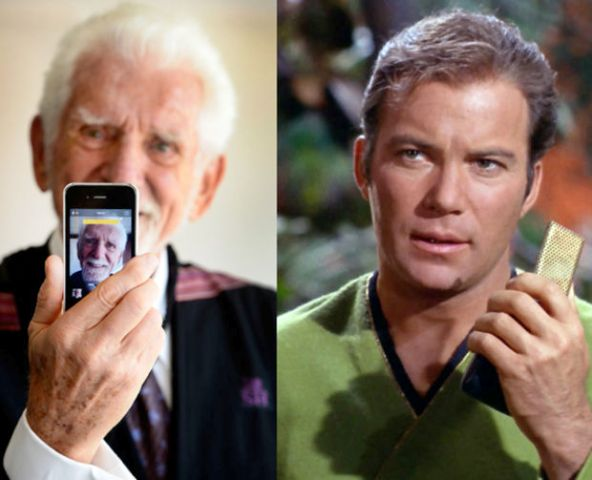博文
科幻与未来
||

左图为“手机之父”Marty Cooper握着手机,右图为《星际迷航》中企业号舰长科克手持通讯器。
科幻与未来
武夷山 编译
美国著名科幻作家、雨果奖得主Kim Stanley Robinson说过,“我们所生活的现在与笼罩在头顶的各式各样的未来交织在一起。质而言之,我们生活在我们所有人共同创作的科幻小说里。”
过去几十年里的许多技术进展都曾在早先的科幻小说中描绘过。例如,号称“手机之父”的美国工程师Marty Cooper受《星际迷航》中描述的通讯器的启发,创造了手机,将幻想变成了现实。
科幻小说考察技术与人类的关系,提出“如果怎样,就会怎样”之类的问题。于是,近年来,美国涌现出一种新的技术咨询领域----用幻想来启发面向未来的技术产品设计。科幻作品和技术之间存在的这种关联被称为“设计幻想”(design fiction),这是美国科幻作家Bruce Sterling于2005年提出来的概念。现在,一些科技公司愿意花钱委托作家们去创作一些想象力丰富的作品。作家们以新创意为模板,围绕委托方的产品市场叙事之潜在未来景观,创作出“如果怎样,就会怎样”(或曰假设情景)的故事。
然后,将这些假设情景嵌入“diegetic prototype”(叙事原型)。叙事原型是英国曼彻斯特大学科学传播学教授David A. Kirby提出的一个概念。它指的是幻想式描述激起公众对新兴技术之社会、文化与伦理意涵进行讨论的各种方式。叙事原型的概念为“设计幻想”这种创造性的技术开发路径提供了基础。Kirby说,可以将设计幻想的对象作为图腾,据此展开一个宏大的故事,但叙事原型不仅仅是讲故事,而且还描述世界。叙事原型属于叙述工具,人们用它绘出一个切入点,由此进入复杂的社会-技术未来之猜想性场景。该过程的最后一步是做出实实在在的技术产品原型,以供讨论和辩论,使得设计幻想进一步迭代和演化,在一连续不断的周期里重新定义现在之场景。
关于叙事原型与设计幻想的关系,Bruce Sterling的一句话讲得很透彻:设计幻想就是对叙事原型之有意识的利用,以悬置人们对变革的不信任。
人们已经尝试采用了各种媒介来创造设计幻想的故事世界,这些媒介包括:物理原型,用户手册原型,数字化应用,视频,短篇小说,漫画,虚构的众筹视频,虚构纪录片,产品样本,报纸,学术论文及摘要之模仿品,等等。
在考察科幻与未来之间的关系时,人们自然就会提出一系列的问题:
----您所观察到的科幻情景将如何显化为现实?
----您将如何动员当今的技术和创造者,就我们的技术未来做出预见,并采取行动将未来打造出来?
----您最欣赏的由科幻作品启发出的发明有哪些?您还希望看到科幻作品启发出哪些目前尚不存在的其他发明?
博主:科幻不仅仅是文学作品了,它为面向未来的新产品的设计做出了贡献。在这里,文学与科学技术不再是相互隔阂的两种文化,而是混融成一体了。
对设计幻想之具体操作过程感兴趣的,可参看以下参考文献。
1. Superflux (2015). "DRONE AVIARY".
2. ^ The Near Future Laboratory. "Helios Quick Start Guide".
3. ^ Design Friction (2015). "Euthanasia Wearable Quick Start Guide" (PDF). Imagination Lancaster.
4. ^ Automato Farm (2014). "Ethical Autonomous Vehicles".
5. ^ Joe Lindley (2014-10-30), A Machine. Learning. (An example of HCI prototyping with design fiction), retrieved 2016-07-05
6. ^ "A Digital Tomorrow". Vimeo. Retrieved 2016-07-05.
7. ^ "Uninvited Guests | superflux". superflux.in. Retrieved 2016-07-05.
8. ^ Maughan, Tim (2013-09-19). "Zero Hours".
9. ^ Jump up to:a b Dalton, Nicholas S.; Moreau, Rebecca; Adams, Ross K. (2016-01-01). Resistance is Fertile: Design Fictions in Dystopian Worlds (PDF). Proceedings of the 2016 CHI Conference Extended Abstracts on Human Factors in Computing Systems (Submitted manuscript). CHI EA '16. New York, NY, USA: ACM. pp. 365–374. doi:10.1145/2851581.2892572. ISBN 9781450340823.
10.^ "$ \ o • o / $". editions.normalfutu.re. Retrieved 2017-01-12.
11.^ Jump up to:a b Sturdee, Miriam; Coulton, Paul; Lindley, Joseph G.; Stead, Mike; Ali, Haider; Hudson-Smith, Andy (2016-01-01). Design Fiction: How to Build a Voight-Kampff Machine (PDF). Proceedings of the 2016 CHI Conference Extended Abstracts on Human Factors in Computing Systems. CHI EA '16. New York, NY, USA: ACM. pp. 375–386. doi:10.1145/2851581.2892574. ISBN 9781450340823.
12.^ "Emotion detector could reveal if a date really finds you attractive: Is this the kind of world we actually want?". www.sciencedaily.com. Retrieved 2016-07-05.
13.^ "Introducing the Empathy Engine". Vimeo. Retrieved 2016-07-05.
14.^ S, N O R M A L. "N O R M A L S — A P P A R E L". apparel.normalfutu.re. Retrieved 2017-01-12.
15.^ Joe Lindley (2015-08-11), Care For a Robot (A design fiction documentary about caring robots), retrieved 2016-07-05
16.^ Near Future Laboratory (2014). "The catalog of the near future's normal ordinary everyday".
17.^ Jump up to:a b Near Future Laboratory (2014). "Winning Formula".
18.^ Jump up to:a b Lindley, Joseph; Coulton, Paul (2015-01-01). Game of Drones. Proceedings of the 2015 Annual Symposium on Computer-Human Interaction in Play. CHI PLAY '15. New York, NY, USA: ACM. pp. 613–618. doi:10.1145/2793107.2810300. ISBN 9781450334662.
19.^ Jump up to:a b Lindley, Joseph; Coulton, Paul (2016-01-01). Pushing the Limits of Design Fiction: The Case For Fictional Research Papers (PDF). Proceedings of the 2016 CHI Conference on Human Factors in Computing Systems. CHI '16. New York, NY, USA: ACM. pp. 4032–4043. doi:10.1145/2858036.2858446. ISBN 9781450333627.
20.^ Blythe, Mark; Buie, Elizabeth (2014-01-01). Chatbots of the Gods: Imaginary Abstracts for Techno-spirituality Research. Proceedings of the 8th Nordic Conference on Human-Computer Interaction: Fun, Fast, Foundational. NordiCHI '14. New York, NY, USA: ACM. pp. 227–236. doi:10.1145/2639189.2641212. ISBN 9781450325424.
21.^ Blythe, Mark (2014-01-01). Research Through Design Fiction: Narrative in Real and Imaginary Abstracts. Proceedings of the SIGCHI Conference on Human Factors in Computing Systems. CHI '14. New York, NY, USA: ACM. pp. 703–712. doi:10.1145/2556288.2557098. ISBN 9781450324731.
https://blog.sciencenet.cn/blog-1557-1171848.html
上一篇:没考出理想成绩,不高兴----日记摘抄824(时在初一)
下一篇:不看球赛和电影,忙复习----日记摘抄825(时在初一)